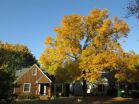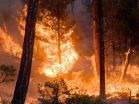(Press-News.org) ST. PAUL, Minn., December 4, 2012 – Trees, water and lawn clearly matter to urban dwellers. For city planners balancing green space with other demands, the question has been just how much green space matters to residents.
Working with lead author Heather Sander of the University of Iowa, economist Robert Haight of the U.S. Forest Service's Northern Research Station estimated how much home buyers are willing to pay for more scenic vistas, better access to outdoor recreation, and greater neighborhood tree cover. Their study, "Estimating the economic value of cultural ecosystem services in an urbanizing area using hedonic pricing," was recently published in the Journal of Environmental Management and is available on-line at: http://nrs.fs.fed.us/pubs/42210
"We have sophisticated ways of measuring many aspects of the services trees provide, such as how much they save homeowners in heating and cooling costs, but people also value natural resources in less tangible ways that are much harder to quantify," said Michael T. Rains, Director of the Forest Service's Northern Research Station. "This study gives cities a tool to elicit another portion of the value of urban natural resources, and knowing these values will enhance regional land use policies."
Estimating the economic value of changes in services associated with neighborhood trees is tricky because those services do not have well-defined markets. Instead, economists use non-market valuation methods, among them hedonic pricing, which estimates the value of an environmental service based on the sales price of a related marketed good, such as residential property. In this case, a home's sale price depends on its location, physical characteristics, and environmental amenities. By estimating the relationship between home sale price and these attributes, Sander and Haight could then determine buyers' willingness to pay for changes in the environmental attributes.
Sander and Haight used data from 5,094 home sales that occurred in Dakota County in 2005 to evaluate how much people were willing to pay for non-material benefits that humans obtain from ecosystems such as increased aesthetic quality, access to outdoor recreation, and neighborhood tree cover. The findings are not surprising – people are willing to pay more for better views of water and lawn, a higher percentage of tree cover, and better access to outdoor recreation areas.
For example, Dakota County home buyers were willing to pay $200-500 more per 10 percent increase in tree cover in their surrounding neighborhood. That willingness to pay represents an important portion of the economic value of services associated with urban trees: the portion that contributes directly to tax bases.
Putting a price on people's value of natural resources is useful in evaluating land-use policy, according to Sander, an Assistant Professor in the University of Iowa's Department of Geography. "Urban planning has to take into account a variety of competing interests," Sander said. "Our intent was to develop a method for using easily accessible information to better understand homeowners' willingness to pay for cultural ecosystem services. This could improve the ability of urban planners to consider these competing interests."
The values expressed in Dakota County homes sales do not necessarily transfer to other communities, according to Haight. "Communities have unique characteristics that can affect how residents value natural resources. While homeowners in Dakota County may generally speak for the Twin Cities, they certainly do not reflect the values of people in Duluth or Fargo."
INFORMATION:
The mission of the U.S. Forest Service is to sustain the health, diversity, and productivity of the nation's forests and grasslands to meet the needs of present and future generations. The agency manages 193 million acres of public land, provides assistance to state and private landowners, and maintains the largest forestry research organization in the world. The mission of the Forest Service's Northern Research Station is to improve people's lives and help sustain the natural resources in the Northeast and Midwest through leading-edge science and effective information delivery.
Housing sales data used to estimate value of urban natural resources
2012-12-05
ELSE PRESS RELEASES FROM THIS DATE:
Telestroke cost effective for hospitals
2012-12-05
PHOENIX — Researchers have found that using telemedicine to deliver stroke care, also known as telestroke, appears to be cost-effective for rural hospitals that do not have an around-the-clock neurologist, or stroke expert, on staff. The research, published today in Circulation: Cardiovascular Quality and Outcomes, is intended to help hospital administrators evaluate telestroke.
In telestroke care, the use of a telestroke robot allows a patient with stroke to be examined in real time by a neurology specialist elsewhere who consults via computer with an emergency room ...
California's N2O emissions may be nearly triple current estimates
2012-12-05
Using a new method for estimating greenhouse gases that combines atmospheric measurements with model predictions, Lawrence Berkeley National Laboratory (Berkeley Lab) researchers have found that the level of nitrous oxide, a potent greenhouse gas, in California may be 2.5 to 3 times greater than the current inventory.
At that level, total N2O emissions—which are believed to come primarily from nitrogen fertilizers used in agricultural production—would account for about 8 percent of California's total greenhouse gas emissions. The findings were recently published in a ...
Rewriting personal history by inventing racist roads not taken
2012-12-05
Evanston, Ill. (December 4, 2012) – In 2008, research showed that expressing support for Barack Obama increased people's comfort in subsequently saying or doing things that might be considered racist. Researchers argued that endorsing a black political figure made people feel as if they had "non-racist credentials" that reduced their concern about subsequently seeming prejudiced. Now this same research group has identified a mental trick that people play to convince themselves that they have these same non-racist credentials: convincing themselves that they were presented ...
Evolution: Social exclusion leads to cooperation
2012-12-05
The study, by IIASA Evolution and Ecology Program postdoctoral fellow Tatsuya Sasaki, provides a simple new model that ties punishment by social exclusion to the benefits for the punisher. It may help explain how social exclusion arose in evolution, and how it promotes cooperation among groups.
"Punishment is a common tool to promote cooperation in the real world," says Sasaki. "And social exclusion is a common way to do it." From reef fish to chimpanzees, there are many examples of animals that promote cooperation by excluding free riders. Humans, too, use social exclusion ...
Predictors of postpartum pelvic joint pain identified among working women
2012-12-05
Philadelphia, PA, December 4, 2012 – A new study of working women has identified factors during pregnancy and postpartum that can predict pain in the joints that comprise the pelvic girdle. While 90 percent of working women in the Netherlands return to work after the birth of their first child, health issues during the postpartum period often require sick leave. Chief among these health issues is pelvic girdle pain (PGP).
"It is important to identify predictors for postpartum PGP, because physicians, obstetricians, midwives, and employers could use them to identify women ...
Synchrotron gives insight into green energy enzymes
2012-12-05
UC Davis chemists have been using a Japanese synchrotron to get a detailed look at enzymes that could help power the green economy. The work was published online Nov. 8 by the journal Angewandte Chemie and is featured on the cover of the Nov. 26 issue.
One option for powering clean, environment friendly vehicles is to run them on hydrogen fuel rather than carbon-based fuels. Cheap catalysts to prepare hydrogen gas (H2) are key to this future "hydrogen economy."
Current man-made catalysts are based on the rare and precious metal platinum. But living cells contain enzymes ...
Predicting, preventing, and controlling pandemics: Making the case for a strategic action plan
2012-12-05
December 4, 2012 – About 60% of infectious diseases are caused by viruses, bacteria and other pathogens that make the jump to humans from other species. This includes some of the most devastating disease outbreaks of the past 30 years, including HIV/AIDS, Ebola, and SARS. Despite the huge and rising toll of such diseases, many gaps remain in our understanding of how these "zoonoses" evolve, develop, and spread—gaps that must be filled if we are to succeed in preventing or at least reducing the impact of a next pandemic.
A new paper published in the Lancet by Stephen ...
Climate models project increase in US wildfire risk
2012-12-05
Scientists using NASA satellite data and climate models have projected drier conditions likely will cause increased fire activity across the United States in coming decades. Other findings about U.S. wildfires, including their amount of carbon emissions and how the length and strength of fire seasons are expected to change under future climate conditions, were also presented Tuesday at the annual meeting of the American Geophysical Union in San Francisco.
Doug Morton of NASA's Goddard Space Flight Center in Greenbelt, Md., presented the new analysis of future U.S. fire ...
Longer life expectancy, aging population necessitate new strategies for prostate cancer care
2012-12-05
The population of the United States is getting older, due not only to aging boomers but also to a four-year increase in life expectancy from 1990 to 2010. An aging population means increased diagnosis of prostate cancer. Statistically, the older the patient at time of diagnosis, the more aggressive the disease – and also the less well the patient is likely to tolerate traditional chemotherapies. In sum, we have more, aggressive prostate cancer that can't be targeted by traditional treatments.
Members of the University of Colorado Cancer Center recently published a review ...
UI researchers help find way to protect historic limestone buildings
2012-12-05
Buildings and statues constructed of limestone can be protected from pollution by applying a thin, single layer of a water-resistant coating.
That's the word from a University of Iowa researcher and her colleagues from Cardiff University in a paper published in the journal Scientific Reports, from the publishers of Nature. In the study, the researchers report a new way to minimize chemical reactions that cause buildings to deteriorate, according to Vicki Grassian, F. Wendell Miller professor in the UI departments of chemistry and chemical and biochemical engineering.
The ...

